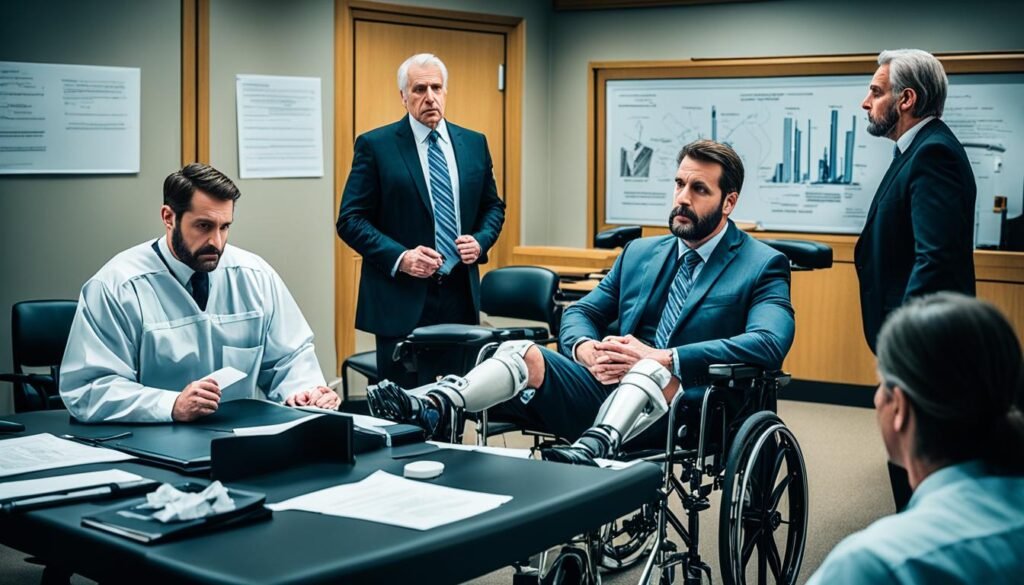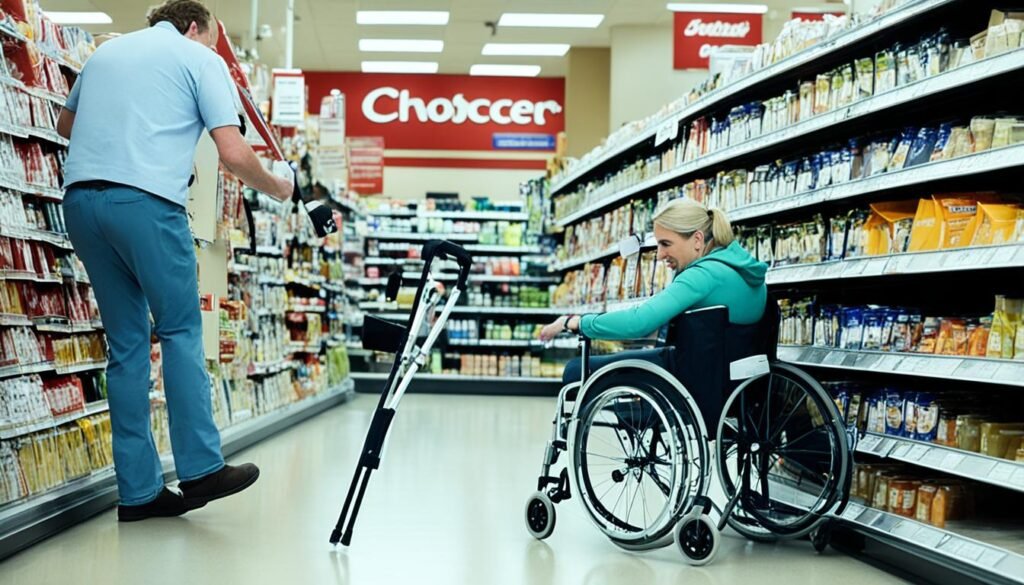Did you know that over 6 million car accidents happen in the U.S. every year1? Personal injury law is key in helping victims of accidents. It makes sure those at fault are held accountable. This law helps victims get financial help or “made whole” after harm from someone else’s mistake or on purpose2.
This guide will cover the basics of personal injury law. We’ll talk about the types of cases, how to file a claim, and what victims can expect.
Key Takeaways
- Personal injury law helps victims get money for harm caused by someone else’s mistake or on purpose.
- Common cases include car accidents, slipping and falling, medical mistakes, and products that don’t work right.
- Victims get a detailed check-up, legal help, and a push for the most money for their injuries.
- The process of making a claim includes talking to a lawyer, collecting evidence, filing the lawsuit, discovery, trial, and possibly settling or appealing.
- Dealing with personal injury law is complex. It’s best to get help from a skilled lawyer.
What is Personal Injury Law?
Personal injury law, also known as tort law, lets someone hurt in an accident get legal help and money for their losses. This happens in civil court because of someone else’s mistake or on purpose3. The main goal is to make the injured person as good as new before the accident3.
Definition and Purpose
Personal injury law gives victims a way to get back what they lost. This includes medical bills, lost pay, pain, and sometimes extra money for really bad actions4. It aims to make the one responsible pay and help the injured person as much as they can4.
In California, personal injury law has its own rules and past cases. For example, you have two years to sue4. Also, your damages might be less if you were partly to blame4. There are special laws for medical mistakes, being hurt on someone else’s property, and product issues3.

California’s personal injury laws try to be fair and help those hurt get the money they need. Knowing about personal injury law helps people deal with claims and protect their rights if they get hurt3.
| Key Aspects of Personal Injury Law in California | Details |
|---|---|
| Statute of Limitations | 2 years from the date of the injury, or 1 year from discovery of the injury if not immediately noticed4 |
| Comparative Negligence | California follows a “pure comparative negligence” rule, where compensation is reduced by the individual’s percentage of fault4 |
| Medical Malpractice Damages | Non-economic damages like pain and suffering are capped at $250,000 in California4 |
| Compensation Coverage | Typically includes medical expenses, lost wages, pain and suffering, and punitive damages in extreme cases4 |
| Key Factors in Claim Outcomes | Severity of injury, evidence of negligence, impact on quality of life, and quality of legal representation4 |
Types of Personal Injury Cases
Common Cases
Personal injury law deals with many situations where people get hurt because of someone else’s mistake or on purpose. Common cases include auto accidents, slip and fall cases, medical malpractice, workplace accidents, premises liability, product liability, and intentional torts5.
Auto accidents happen often and can be caused by things like texting while driving, speeding, or driving drunk5. Slip and fall incidents are also common and can happen because of dangerous places or things5.
Medical malpractice claims happen when doctors or other healthcare workers don’t do their job right and hurt the patient5. Product liability cases happen when a product is broken and hurts someone, causing serious harm or death5.
Workplace accidents can happen in many places and include things like falling, getting hurt by machines, being exposed to harmful substances, or getting repetitive stress injuries5. Intentional torts are when someone hurts someone on purpose, like in an assault or battery5.
Other common cases include dog bite incidents, pedestrian accidents, motorcycle accidents, wrongful death claims, construction accidents, nursing home abuse, boating accidents, and train accidents56.
No matter the type of injury, victims might be able to get money for medical bills, lost wages, pain, and other losses6. It’s important to get legal help to make sure their rights are looked after and they get the justice they deserve.

Understanding Personal Injury Law
Personal injury law helps you get back on your feet if someone else was careless7. You can claim money for medical bills, lost wages, pain, and more7. Many people don’t seek compensation because they don’t know their rights or the benefits of a claim7. Knowing your rights can help you make smart choices and avoid financial trouble from an accident you didn’t cause.
With personal injury law, you can sue those who hurt you or caused you loss7. There are different types of claims, like accidents, product defects, and intentional harm7. Most claims are against the person directly to blame, and sometimes there are multiple people to blame7. Employers can also be held responsible for their employees’ actions at work7.
Insurance companies often offer settlements or payments up to policy limits when their policies cover the harm7. To win a case, you must prove the defendant was liable and caused your harm7. You can claim damages like medical bills, lost wages, and more7. Some states limit certain damages, like in medical malpractice cases7.
Claims can be settled out of court, where insurers offer money to avoid a lawsuit7. A lawyer can help you understand the law, go through the claims process, and get the most compensation7.
The law firm, Block O’Toole & Murphy, has won many personal injury cases and settlements over $1,000,000 since 20128. They handle cases like car accidents, construction accidents, and more8.
Economic damages include medical bills, lost wages, and property damage8. Non-economic damages cover pain, emotional distress, and less enjoyment of life8. Rarely, punitive damages are awarded for extreme recklessness8.
The time limit to file a lawsuit varies by state, usually 1 to 10 years after the accident8. The firm advises acting quickly to ensure you can prove your case and avoid losing your right to compensation8.
Car accidents are a big part of personal injury cases9. The average award for a car accident is $16,0009. In Minnesota, you need over $4,000 in medical costs and the injury must last over 60 days to sue9. Minnesota insurance policies must offer at least $20,000 for medical and non-medical costs9.
“By understanding your rights, you can make informed decisions and ensure you are not financially burdened by an accident that wasn’t your fault.”
The Claims Process
Going through the personal injury claims process can feel overwhelming. But, with the right help, victims can protect their rights and get the compensation they need. This process has several key steps, each important for a successful claim.
Steps Involved
- Consult with a personal injury law firm: Start by talking to a skilled personal injury lawyer10. They offer valuable advice, check your case’s strength, and guide you on what to do next.
- Investigation to gather evidence: It’s crucial to gather evidence for a strong case. This means getting witness stories, police reports, and medical records10.
- Filing the lawsuit: If talking to the insurance company doesn’t work out, you might need to sue11.
- Discovery phase: Here, both sides look into each other’s claims and share information and documents11.
- Trial: If no settlement is reached, the case goes to trial. A judge or jury will then decide based on the evidence11.
- Settlement or Appeal: If you win the trial, you might get a settlement. If not, you can appeal the decision11.
Having a skilled legal team is key during the claims process10. They can handle the complex legal stuff, talk to insurance companies, and make sure you get the right compensation.
| Step | Description |
|---|---|
| Consultation | Meet with a personal injury attorney to discuss the case and determine the best course of action. |
| Investigation | Gather evidence, witness statements, and medical records to build a strong case. |
| Filing Lawsuit | If a settlement cannot be reached, the next step is to file a personal injury lawsuit. |
| Discovery | Both parties investigate each other’s claims and exchange relevant information. |
| Trial | If a settlement is not reached, the case will proceed to trial for a judge or jury to determine the outcome. |
| Settlement/Appeal | The claimant may receive a settlement or have the option to appeal the decision if unsatisfactory. |
“Having a personal injury attorney by your side can greatly improve your chances of a successful outcome in the claims process.”
Damages and Compensation
If you win your personal injury case, you can be “made whole.”12 This means you’ll be put back in the position you were before the accident12. You can get money for medical bills, lost wages, pain, emotional distress, and sometimes punitive damages12. The amount you get depends on your case and the laws where you live12.
There are two kinds of damages: special and general12. Special damages are easy to measure and cover things like medical bills and lost wages12. General damages are harder to measure and include pain, emotional distress, and mental trauma12. Figuring out the value of pain and suffering can be tricky, but it depends on the treatment you got and how bad your injuries were12.
In trials, a jury decides how much to pay for general damages like pain and suffering12. A good lawyer can help figure out what you should get by looking at past cases and settlements12. If the insurance company doesn’t offer a fair deal, you can take them to court12. There, a jury will decide how much you should get12. It’s important to prepare well and tell the jury about your pain and suffering to get a fair award12.
Usually, “special damages” cover medical costs, lost wages, and property loss13. “General damages” are for pain, emotional distress, and other non-monetary losses13. The value of your case depends on how bad your injuries are, your insurance, who was at fault, and how believable you and your witnesses are13. If you’re running out of time to file a claim, it could affect how much you get13. If you’re partly to blame, you might get less money because of “comparative negligence.”13
“Securing fair compensation for your personal injuries is crucial, and an experienced attorney can guide you through the complex legal process.”
Conclusion
Learning about personal injury law is key to getting justice and fair compensation. If you or someone close to you has been hurt, don’t face this alone. The legal experts at Super Attorneys Of Irvine in California have years of experience to help you. They handle many cases like car accidents, work injuries, slips, and medical mistakes14. They look for negligence, which means showing someone was careless and caused your harm14.
Dealing with legal rights and claims can feel overwhelming. But, having a skilled personal injury attorney boosts your chances of winning14. They help with everything from collecting evidence to preparing for court14. Most cases settle out of court, but some go to trial where a judge or jury decides who was at fault15.
For top-notch advice on your personal injury case, check out businesslawyersirvine.com or call 949-996-9546. The team at Super Attorneys Of Irvine aims to get you the compensation you need and help you feel at peace. Don’t delay – start your journey to justice now.
FAQ
What is the purpose of personal injury law?
What are some common types of personal injury cases?
How can I recover compensation if I’ve been injured due to someone else’s negligence?
What is the typical process of a personal injury claim?
What types of damages can I recover in a successful personal injury case?
Source Links
- https://www.linkedin.com/pulse/understanding-personal-injury-law-comprehensive-guide
- https://roachlaw.com/understanding-personal-injury-law-a-comprehensive-guide-to-your-rights-and-recovery/
- https://hannlawfirm.com/blog/hann-law-personal-injury-law-in-california-what-you-should-know/
- https://www.californiaaccidentattorneysblog.com/understanding-californias-laws-on-personal-injury-a-comprehensive-guide/
- https://casepacer.com/resources/types-of-personal-injury-cases
- https://www.straccilaw.com/blog/common-types-of-personal-injury-cases
- https://www.forbes.com/advisor/legal/personal-injury/personal-injury-law/
- https://www.blockotoole.com/personal-injury-lawsuits/law-basics/
- https://bk-lawgroup.com/blog/what-is-personal-injury-law/
- https://eisenberglaw.org/firm-overview/articles/understanding-the-personal-injury-insurance-claim-process/
- https://mossberginjurylaw.com/understanding-personal-injury-claims-a-comprehensive-guide-for-las-vegas-residents-2/
- https://www.mahaneypappaslaw.com/library/understanding-damages-in-massachusetts-personal-injury-cases.cfm
- https://www.nolo.com/legal-encyclopedia/damages-how-much-personal-injury-32264.html
- https://www.starleaf.com/blog/understanding-personal-injury-law-your-legal-rights-and-options/
- https://www.askadamskutner.com/personal-injury/understanding-the-process-of-a-personal-injury-lawsuit/

